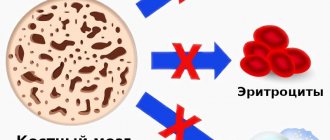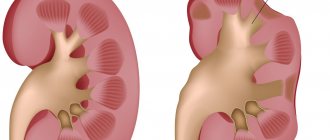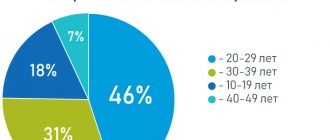Published: 05/18/2018 Updated: 03/09/2021
Anemia is a dangerous condition. In children, it provokes a slowdown in mental and physical development, and speech impairment. In pregnant women, it can cause fetal pathologies and complications for the mother. Vegetarians and those who constantly adhere to low-protein diets are at risk of decreased performance, cognitive function, headaches and dizziness. If you feel that you are sorely lacking in energy and strength, get tested. More than half of all anemias remain undiagnosed. And without laboratory tests it is impossible to detect anemia.
What is anemia?
Anemia is a condition associated with a decrease in hemoglobin levels in the blood (below 110 g/l). Often accompanied by a decrease in the number of red blood cells - red blood cells or their total volume.
The main function of red blood cells is to transport oxygen from the lungs to various organs and tissues and remove carbon dioxide. The transport function is carried out thanks to hemoglobin, the main component of red blood cells. Hemoglobin consists of the protein (globin) iheme, which in turn consists of ferrous iron and protoporphyrin IX. 70% of the iron in the body is found in red blood cells.
The first signs of anemia in women after 30
Female anemia has certain characteristics of its course. It begins to develop when the hemoglobin level drops to 90-120 g/l. This anemia is considered mild and may not manifest itself in any way. However, if a woman is attentive to her health, then she will still notice minimal signs of a developing disorder.
The first symptoms of anemia in women after 30 include:
- Decreased performance. All those tasks and responsibilities that a woman previously performed will now be difficult for her.
- During the day, sleepiness begins to bother her more and more often, despite the fact that the woman has not changed her daily routine and has enough time to sleep at night.
- Floaters and flashes periodically appear before the eyes.
- When in a cool room, a woman will feel very cold. Such an unexpected reaction to low temperature should lead to the idea of developing anemia.
- The skin of the face becomes dry, wrinkles and cracks appear on it.
- The mucous membranes suffer from ulcerations.
- You definitely need to pay attention to nails that become brittle and dull, and longitudinal stripes may appear on them.
- Anemia affects the condition of the hair. At the age of 30, a woman may find that her hair begins to turn gray and fall out.
- From the mental perspective, changes caused by anemia are more difficult to notice, but most women still note that they have become much more irritable and whiny. There is a weakening of memory and concentration.
The listed symptoms may not develop fully and not always. However, anemia cannot manifest itself completely asymptomatically. The main thing is to listen to your body and not ignore its signals.
Causes of anemia
There are quite a few factors that provoke anemia. Anemia can occur due to:
- unbalanced diet (iron deficiency, deficiency or excess of vitamin B12, vegetarianism);
- disorders of folic acid metabolism;
- increased need of the body for nutrients (growth period - adolescence, pregnancy);
- frequent infectious diseases (cytomegalovirus, herpes virus, hepatitis);
- heavy metal poisoning.
In addition, anemia often accompanies diseases of the gastrointestinal tract (chronic gastritis), develops against the background of helminthic infestations, especially often in children (parasites attach to the intestinal wall and can cause bleeding), uterine bleeding (heavy menstruation, endometriosis).
Anemia
Anemia is a pathological condition caused by a decrease in the number of red blood cells in the blood and/or a decrease in the concentration of hemoglobin in the red blood cells themselves.
Erythrocytes (red blood cells, RBC) are the largest population of blood cells. Red blood cells contain hemoglobin (Hb), which binds oxygen molecules in the lungs and delivers them to the tissues. In the opposite direction - from the tissues to the lungs - hemoglobin transports carbon dioxide molecules. In other words, hemoglobin ensures the respiration process. The red blood cell has the shape of a disk, concave on both sides. Such a device significantly increases the surface area on which gas exchange occurs. Red blood cells are small in size, which allows them to pass through the narrowest blood vessels (capillaries, arterioles, venules). One red blood cell lives on average up to 120 days.
Low hemoglobin is one of the criteria that must be paid attention to not only when diagnosing anemia itself, but also to assess its severity. A decrease in the amount of hemoglobin in red blood cells occurs when there is insufficient supply of iron during the maturation of cells in the red bone marrow.
There are several classifications of anemia depending on the causes, the mechanisms of anemia development and the severity of changes in blood parameters. They are necessary for the doctor to understand what is causing the current condition. This helps to choose the best tactics for further examination, conduct differential diagnosis and prescribe effective treatment.
The diagnosis and treatment of anemia is carried out by general practitioners, general practitioners, and family doctors. In the case of a severe or malignant course of the disease, the intervention of a hematologist may be required, as well as a more detailed and specialized examination.
There are many reasons for the development of anemia. Anemia is often a complication of an underlying chronic disease.
Iron deficiency anemia develops either when there is insufficient intake of iron in the body, or when the body’s increased need for iron.
Often both factors are present to varying degrees.
The causes of insufficient iron intake may be diseases of the gastrointestinal tract, in which the processes of digestion and absorption of food are disrupted. Consumption of foods containing low amounts of iron or iron in a form that is difficult to digest (exclusively plant-based diet). Some foods (alcohol, milk, coffee) or medications (antibacterial, antacid drugs) interfere with the absorption of iron from food.
The body's need for iron (“iron consumption”) increases significantly in children during periods of active growth and in women during pregnancy and breastfeeding.
Anemia often complicates the course of diseases accompanied by prolonged blood loss (especially against the background of impaired absorption of food):
- peptic ulcer of the stomach and duodenum;
- inflammatory bowel diseases;
- uterine fibroids, endometriosis;
- malignant neoplasms;
- bleeding disorders;
- helminthic infestations.
The human body cannot synthesize iron! We get iron only from food. Not only the amount of iron in foods matters, but also its availability for absorption by the body. Animal products (beef, lamb, liver) contain heme iron. It is absorbed by the body most efficiently. Plant foods (vegetables, fruits, cereals) contain non-heme iron. The human body does not absorb non-heme iron well.
The main reason for the development of iron deficiency anemia, according to experts from the World Health Organization (WHO), is an unhealthy (unbalanced) diet. If you do not consume meat products, then you must remember that iron is absorbed much worse from plant foods. Plan your diet wisely to avoid iron deficiency.
Improves iron absorption:
| Impairs iron absorption:
|
Another type of anemia is a disease caused by vitamin B12 deficiency.
B12 deficiency anemia develops due to a lack of cyanocobalamin.
The reasons for the deficiency may be:
- Insufficient intake of vitamin B12 from food (strict vegetarianism), since cyanocobalamin is found only in meat products, milk, eggs, fish and seafood.
- Impaired secretion of “internal Castle factor” by the stomach;
- Impaired absorption of vitamin B12 in the small intestine;
- Competitive consumption of vitamin B12;
- Increased consumption of vitamin B12;
- Decreased vitamin B12 reserves;
- Violation of vitamin B12 transport;
- The absence of transcobalamin or the appearance of antibodies to it.
Symptoms of anemia:
- Pale skin, cracks, “jams” in the corners of the mouth
- Brittle nails, thinning and striated nails
- Hair loss, fragility, structural damage
- Increased fatigue, decreased performance
- Rapid heartbeat, dizziness, shortness of breath accompany even slight physical activity
Iron deficiency anemia is characterized by
- Perversion of taste: addiction to inedible foods - raw meat, frozen semi-finished products; desire to eat inedible substances - chalk, earth, ice, clay.
- Perversion of smell: addiction to unpleasant odors, for example, gasoline, acetone, paint, etc.
What tests can be done for those who suspect they have anemia? The most accessible and simplest is a general blood test
- Complete blood count (without leukocyte formula and without ESR), venous blood.
If the results of the analysis reveal changes in the number of red blood cells, hemoglobin, hematocrit, erythrocyte indices (MCV, MCH, MCHC, RDW), then it is necessary to consult a doctor to prescribe further examination and treatment.
For reference:
Hematocrit (Ht) is an indicator that characterizes the number of cells per unit volume of whole blood. The hematocrit value depends on the number and shape of red blood cells. A decrease in hematocrit level also characterizes a decrease in the content of red blood cells in the blood.
MCV ( mean corpuscular volume) – the average volume of a red blood cell, reflects the size of the cells. In the presence of long-term iron deficiency, maturing red blood cells become small, microcytes appear in the blood, and the MCV index decreases. If there is a deficiency of vitamins B12 and B9, the maturing cells become large, macrocytes appear in the blood, and this indicator increases. Both conditions negatively affect the main function of red blood cells - the transport of oxygen and carbon dioxide. In the case of macrocytic anemia, their ability to pass through small-diameter vessels is reduced, and their lifespan is reduced.
MCH ( mean corpuscular hemoglobin) - the average hemoglobin content in a red blood cell, reflects the same processes as the previous MCV indicator. With prolonged iron deficiency, red blood cells enter the bloodstream, which during the process of growth and maturation lacked this microelement, and they become not only small, but also insufficiently saturated with hemoglobin. MCH begins to decrease, and a state of hypochromia develops. Red blood cells become pale and their functioning deteriorates. Previously, a color index was calculated to assess the state of hemoglobin saturation of erythrocytes; MCH is its modern, more accurate analogue and allows one to differentiate anemia into normochromic, hypochromic and hyperchromic. In case of deficiency of vitamins B12 and B9, the opposite situation occurs. Maturing red blood cells are oversaturated with hemoglobin, this indicator begins to increase, and a state of hyperchromia develops. Taken together, these two indicators will help the doctor to guess the nature of anemia based only on the results of a general blood test.
MCHC ( mean corpuscular hemoglobin concentration) is the average concentration of hemoglobin in a red blood cell. Reflects the concentration of hemoglobin in a red blood cell. Decreased in iron deficiency hypochromic anemia and diseases accompanied by impaired hemoglobin synthesis at any stage. Increases in hyperchromic B12 and B9 deficiency anemia.
RDW ( red blood cell distribution width) is the width of the distribution of red blood cells by volume. This indicator depends on the average volume of the erythrocyte, therefore, with an increase or decrease in MCV, its increase is observed, which indicates that there are cells of different volumes in the blood, for example, macrocytes and normocytes, or microcytes and normocytes.
For a comprehensive examination, when the cause of anemia is unknown, you can use the Biochemical diagnosis of anemia program, which includes parameters reflecting the metabolism and supply of iron in the body, the supply of vitamin B9 (folic acid) and vitamin B12 (cyanocobalamin), as well as erythropoietin - the hormone that triggers erythropoiesis (maturation of new red blood cells).
- Transferrin - carries out extracellular transport of iron to all cells of the human body.
- Soluble transferrin receptors (sTfR). One of the important diagnostic criteria on the basis of which true iron deficiency can be established. The entry of iron into the cell occurs after the interaction of the iron-transferrin complex with specific proteins - receptors on the cell membrane. The concentration of transferrin receptors depends on two factors - the amount of deposited iron in ferritin and the proliferative activity of the cell. The amount of soluble transferrin receptors is a sensitive indicator of both erythropoiesis activity and iron deficiency. With anemia that has developed as a complication of chronic diseases, this indicator does not change (remains normal). This helps determine the underlying cause of anemia.
- Ferritin is a deposited form of iron, reflecting its total reserve in the body. A decrease in ferritin concentration in the blood is a marker of iron deficiency.
Sources:
- Federal clinical guidelines for the diagnosis and treatment of iron deficiency anemia Official publication Moscow 2015
- Strutynsky A.V. Diagnosis and treatment of iron deficiency anemia of breast cancer “Medical Review” No. 11 of May 14, 2014 p. 839
- Anemia: iron deficiency, B12 deficiency and anemia of chronic diseases. Information letter for hematologists, therapists, interns and residents. Rostov-on-Don, 2013.
How to recognize anemia?
Typical symptoms of anemia caused by hypoxia of organs and tissues are dizziness, fatigue, weakness, tinnitus, shortness of breath when climbing stairs, decreased performance. There is also a decrease in appetite, pale skin (in some cases yellowing), and “stubs” in the corners of the mouth. Hair may begin to fall out and the condition of nails may deteriorate. In addition, the mood changes and apathy and irritability appear, even if everything is fine.
If you notice such changes, do not rush to take iron or vitamin supplements or take B12 injections. The doctor gives a conclusion about anemia based on laboratory parameters. And taking medications on your own can be unsafe.
Manifestations of iron deficiency anemia
Manifestations of anemia consist of 2 main syndromes: sideropenic and general anemic.
Sideropenic syndrome manifests itself:
- Seizures in the corners of the mouth;
- Glossitis - characterized by a feeling of pain, distension in the tongue, redness of its tip, and subsequently atrophy of the papillae;
- Inflammation of the red border of the lips;
- Dystrophic changes in the skin and its appendages (dry and pale skin, premature wrinkles, brittle nails and hair, the appearance of small cracks);
- Difficulty and painful swallowing of dense foods;
- Muscle weakness;
- Perversion of taste (there is a desire to eat inedible objects - chalk, tooth powder, coal, clay, sand, raw dough, minced meat);
- Perversion of the sense of smell (attraction to the smells of gasoline, kerosene, acetone, varnish, paints, dampness);
- Blue sclera syndrome;
- A pronounced predisposition to acute respiratory viral infections and other infectious and inflammatory processes.
General anemic syndrome manifests itself when the level of hemoglobin and red blood cells decreases.
Diagnosis of anemia
To diagnose anemia at CITILAB you can undergo the following tests:
- 11-10-001 – General blood test
- 95-13-211 – Vitamin B12
- 33-20-038 – Folic acid (folates)
- 26-20-100 – Serum iron
You can also run profile 99-00-026 - “Chronic Anemia”, which includes additional parameters for diagnosing and determining the type of anemia. For example, ferritin, which reflects how much ferric ions are deposited; total serum binding capacity, haptoglobin, transferritin and other important indicators.
Diagnostics
To diagnose iron deficiency anemia, you should consult a physician or pediatrician, and in complex cases, a hematologist. First of all, the doctor will interview the patient, find out the nature of the complaints, dietary habits, the presence of chronic diseases, etc. Then a clinical blood test must be performed with the preparation of the leukocyte formula. With its help, it is possible to detect not only a decrease in the concentration of hemoglobin and red blood cells, but also other important changes in the blood, in particular:
- blood color index – less than 0.8;
- average erythrocyte volume – less than 70 µm3;
- the average hemoglobin content in an erythrocyte is less than 24 pg;
- hematocrit – less than 40% for men and less than 35% for women;
- ESR.
If changes are detected in the results of the UAC, a biochemical blood test is prescribed. As a rule, they investigate:
- serum iron level;
- ferritin level;
- total iron-binding capacity of blood serum;
- erythropoietin concentration;
- coefficient of transferrin saturation with iron.
When diagnosing iron deficiency anemia, a search must be made for the reasons that triggered its development. For this purpose the following may be prescribed:
- stool test for the presence of occult blood;
- X-ray examination, which is often carried out using contrast (gastrointestinal tract, chest);
- CT;
- endoscopic examination (esophagogastroduodenoscopy, fibrocolonoscopy);
- Ultrasound of the abdominal organs, kidneys, thyroid gland.
In rare cases, bone marrow puncture examination is performed.
Often in such situations, consultations with specialized specialists involved in the diagnosis and treatment of diseases that provoke the development of IDA are required. This could be an obstetrician-gynecologist, urologist, gastroenterologist, etc.
Replenish iron deficiency
To prevent iron deficiency anemia, in addition to the iron or vitamin supplements prescribed by your doctor, it is recommended to change your diet after receiving test results. It must contain foods rich in iron and microelements (copper, cobalt, manganese, nickel, vitamin C), which help the absorption of this vital essential metal.
| Foods high in Fe (>5 mg/100 g product) | Foods with moderate Fe content (1-5 mg/per 100 g of product) | Foods rich in copper, nickel, cobalt, manganese, vitamin C |
|
|
|
Interesting fact. Iron is best absorbed from meat products.
Attention to hemoglobin
Low hemoglobin is a phenomenon that is not always given due attention. Few doctors make the diagnosis “anemia” a separate line. We generally believe that there is nothing terrible here, “all my life I’ve had this hemoglobin - and it’s okay, it’s alive.” At the same time, due to a decrease in hemoglobin, all organs, systems, and tissues of the body regularly experience a lack of oxygen and receive less nutrition.
What hemoglobin is considered low? Here it is worth turning to the average WHO data, which are also used for laboratory testing. So, the standards look like this:
Men - below 130 g/l;
Women - below 120 g/l.
It is important to remember that anemia is not an independent disease, but a manifestation and/or complication of another serious disease. It cannot be ignored, and in any case the life prognosis is unfavorable. I'm not exaggerating. When a person has a heart attack or stroke (and these diseases are not uncommon in our country), anemia significantly aggravates the course of the disease, causes additional difficulties in treatment and worsens the prognosis. After all, how to save a person whose blood does not carry oxygen to his organs?
Become an "iron man". Low hemoglobin is a sign of ulcers and even cancer Read more
Physiological norms of iron and vitamin B12 and folic acid
In different countries, the average iron intake varies from 10 to 22 mg/day. According to the standards recommended in Russia, for men this level is 8-10 mg/day, for women it is 1.5 times more - 15-20 mg/day. For children - 4-18 mg/day. A sufficient level of folic acid for adults is 400 mcg/day, for children - from 50 mcg every day. Men and women should get at least 3 mcg/day of vitamin B12.
Be healthy!
Author:
Baktyshev Alexey Ilyich, General Practitioner (family doctor), Ultrasound Doctor, Chief Physician









